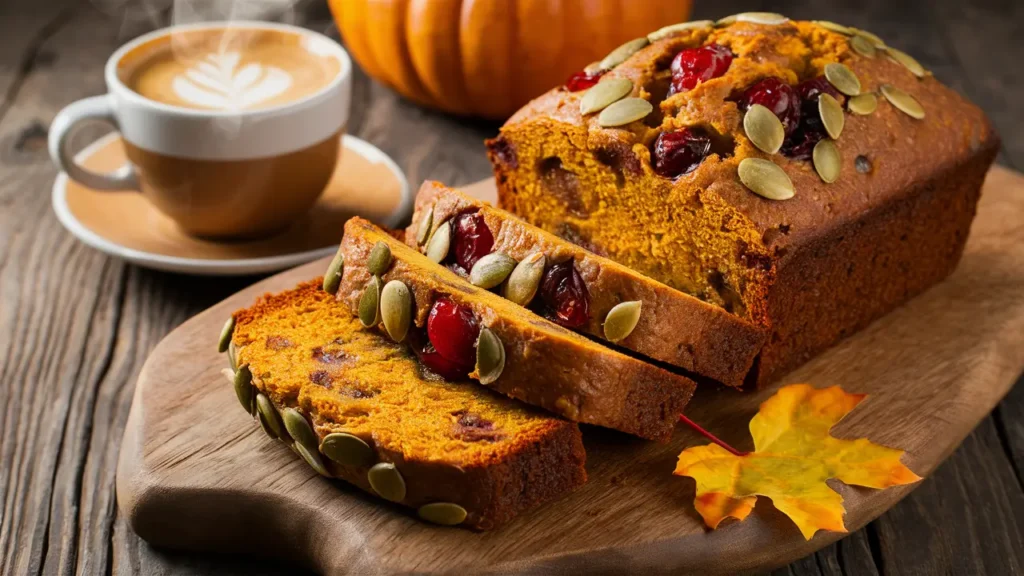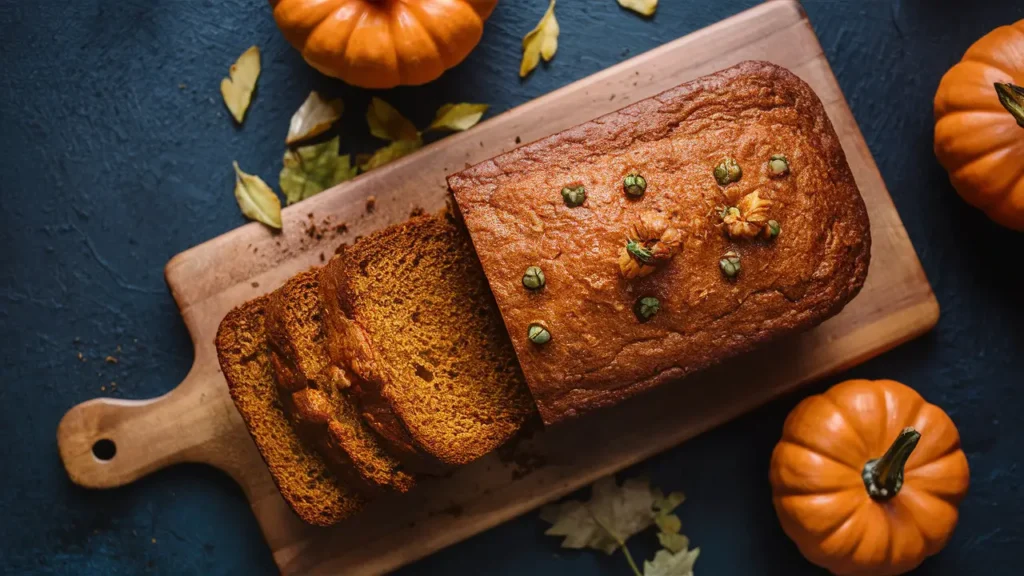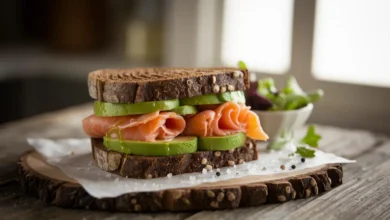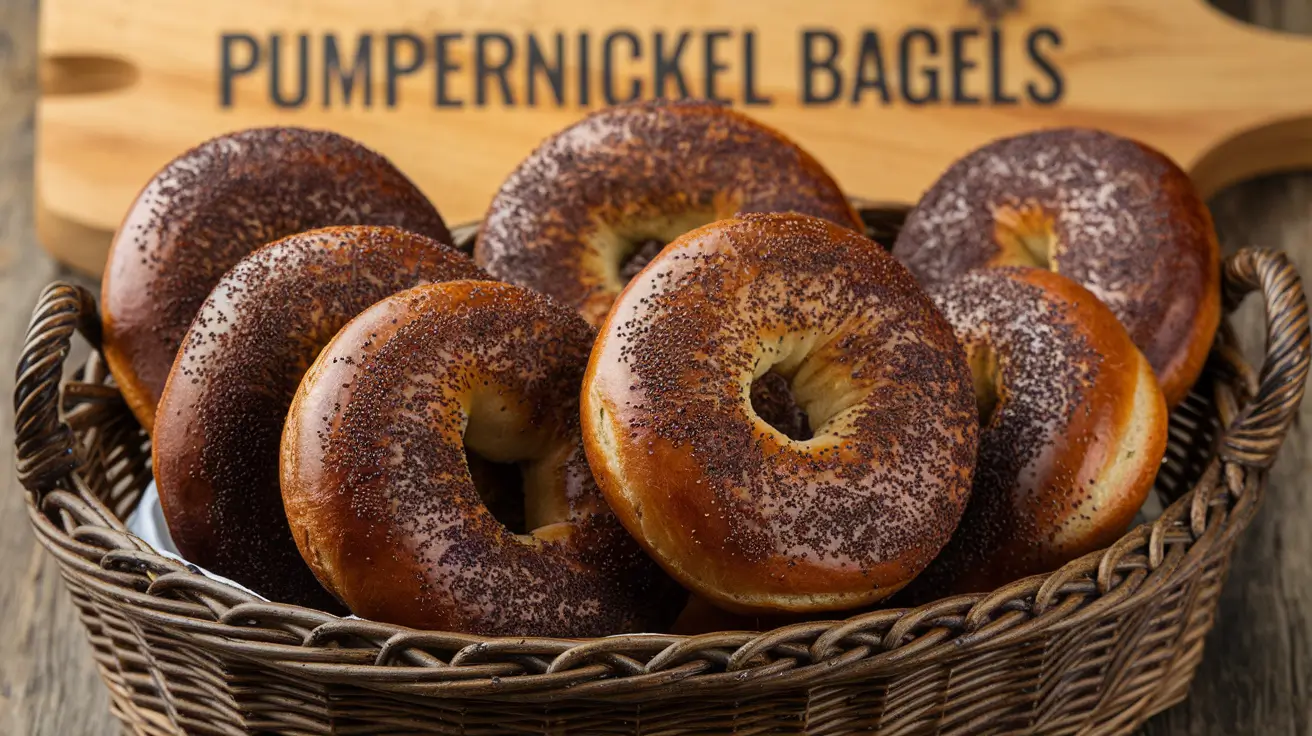The Ultimate Guide to Paleo Pumpkin Bread: Wholesome Autumn Delights

Table of Contents
- Introduction: The Allure of Paleo Pumpkin Bread
- Understanding the Paleo Diet and Its Benefits
- The Perfect Paleo Pumpkin Bread: A Classic Recipe
- Paleo Pumpkin Cranberry Bread: A Tart Twist
- Coconut Flour Magic: Paleo Pumpkin Bread with a Tropical Touch
- Banana Meets Pumpkin: A Fruit-Powered Paleo Bread
- The Science Behind Paleo Baking
- Sourcing Quality Ingredients for Your Paleo Pumpkin Bread
- Tools and Techniques for Perfect Paleo Bread
- Nutritional Benefits of Paleo Pumpkin Bread
- Storing and Serving Your Paleo Pumpkin Bread
- Troubleshooting Common Paleo Baking Issues
- Seasonal Variations: Adapting Your Paleo Pumpkin Bread
- Paleo Pumpkin Bread for Special Diets
- Conclusion: Embracing the Paleo Pumpkin Bread Lifestyle
1. Introduction: The Allure of Paleo Pumpkin Bread

As the crisp autumn air settles in and leaves turn to vibrant shades of gold and crimson, our culinary cravings shift towards warm, comforting flavors. Enter paleo pumpkin bread – a delightful fusion of prehistoric eating principles and modern-day indulgence. This guide will take you on a journey through the world of paleo pumpkin bread, offering not just recipes, but a comprehensive understanding of this healthful treat.
Whether you’re a seasoned paleo enthusiast or simply curious about grain-free baking, this article will equip you with the knowledge and skills to create the perfect loaf. From classic recipes to exciting variations like cranberry-studded slices and coconut flour-based creations, we’ll explore the versatility of paleo pumpkin bread. So, preheat your oven and prepare to embark on a culinary adventure that’s as nutritious as it is delicious.
2. Understanding the Paleo Diet and Its Benefits

Before we dive into the world of paleo pumpkin bread, let’s take a moment to understand the principles behind the paleo diet. Also known as the “caveman diet” or “stone-age diet,” the paleo lifestyle aims to emulate the eating habits of our prehistoric ancestors.
Key Principles of the Paleo Diet:
- Whole Foods Focus: Emphasis on unprocessed, natural foods.
- Protein-Rich: Includes plenty of meat, fish, and eggs.
- Healthy Fats: Incorporates nuts, seeds, and healthy oils.
- Fruit and Vegetables: Abundant in fresh produce.
- Grain-Free: Eliminates all grains, including wheat, barley, and oats.
- Dairy-Free: Excludes most dairy products.
- Sugar-Free: Avoids refined sugars and artificial sweeteners.
Benefits of the Paleo Diet:
- Improved Blood Sugar Control: By eliminating refined carbohydrates, the paleo diet can help stabilize blood sugar levels.
- Weight Management: The high protein and fiber content can promote feelings of fullness and aid in weight control.
- Reduced Inflammation: Many paleo-approved foods have anti-inflammatory properties.
- Better Digestive Health: Eliminating processed foods and grains can improve gut health for some individuals.
- Increased Nutrient Density: Focus on whole foods ensures a diet rich in vitamins, minerals, and antioxidants.
By understanding these principles, we can appreciate how paleo pumpkin bread fits into this lifestyle – offering a grain-free, nutrient-dense alternative to traditional baked goods.
3. The Perfect Paleo Pumpkin Bread: A Classic Recipe
Now that we’ve laid the groundwork, let’s dive into our star recipe – a classic paleo pumpkin bread that captures the essence of autumn while adhering to paleo principles.
Ingredients:
- 1 cup almond flour
- 1/4 cup coconut flour
- 1 teaspoon baking soda
- 1 tablespoon pumpkin pie spice
- 1/4 teaspoon sea salt
- 4 large eggs
- 3/4 cup pumpkin puree
- 1/3 cup maple syrup
- 1/4 cup coconut oil, melted
- 1 teaspoon vanilla extract
Instructions:
- Preheat your oven to 350°F (175°C) and line a 9×5-inch loaf pan with parchment paper.
- In a large bowl, whisk together the almond flour, coconut flour, baking soda, pumpkin pie spice, and sea salt.
- In a separate bowl, beat the eggs, then add the pumpkin puree, maple syrup, melted coconut oil, and vanilla extract. Mix well.
- Pour the wet ingredients into the dry ingredients and stir until thoroughly combined.
- Transfer the batter to the prepared loaf pan, smoothing the top with a spatula.
- Bake for 50-60 minutes, or until a toothpick inserted into the center comes out clean.
- Allow the bread to cool in the pan for 10 minutes, then transfer to a wire rack to cool completely.
This classic paleo pumpkin bread recipe serves as an excellent base for experimentation. The almond and coconut flours provide a nutty, slightly sweet flavor that complements the pumpkin beautifully, while the maple syrup offers natural sweetness without refined sugars.
4. Paleo Pumpkin Cranberry Bread: A Tart Twist

For those seeking to add a burst of flavor and a pop of color to their paleo pumpkin bread, consider incorporating cranberries. These tart little berries not only provide a delightful contrast to the sweet, spiced pumpkin but also pack a nutritional punch with their high antioxidant content.
Ingredients:
(Use the classic recipe as a base, and add the following)
- 1 cup fresh or frozen cranberries
- 1/4 cup chopped pecans (optional)
- Zest of one orange
Instructions:
- Follow the classic paleo pumpkin bread recipe through step 4.
- Gently fold in the cranberries, chopped pecans (if using), and orange zest.
- Continue with steps 5-7 from the classic recipe.
The addition of cranberries introduces a tangy flavor that cuts through the richness of the pumpkin, while the orange zest adds a bright, citrusy note. The pecans provide a pleasant crunch and complement the nuttiness of the almond flour.
5. Coconut Flour Magic: Paleo Pumpkin Bread with a Tropical Touch

For those with nut allergies or simply looking to change up their paleo baking, coconut flour offers an excellent alternative. This recipe showcases the unique properties of coconut flour, resulting in a slightly denser, more tropical-tasting pumpkin bread.
Ingredients:
- 3/4 cup coconut flour
- 1 tablespoon pumpkin pie spice
- 1 teaspoon baking soda
- 1/4 teaspoon sea salt
- 6 large eggs
- 1 cup pumpkin puree
- 1/2 cup coconut oil, melted
- 1/2 cup maple syrup
- 1 teaspoon vanilla extract
- 1/4 cup unsweetened shredded coconut (for topping)
Instructions:
- Preheat your oven to 350°F (175°C) and line a 9×5-inch loaf pan with parchment paper.
- In a large bowl, whisk together the coconut flour, pumpkin pie spice, baking soda, and sea salt.
- In a separate bowl, beat the eggs, then add the pumpkin puree, melted coconut oil, maple syrup, and vanilla extract. Mix well.
- Pour the wet ingredients into the dry ingredients and stir until thoroughly combined. The batter will be thick.
- Transfer the batter to the prepared loaf pan, smoothing the top with a spatula. Sprinkle the shredded coconut over the top.
- Bake for 55-65 minutes, or until a toothpick inserted into the center comes out clean.
- Allow the bread to cool in the pan for 10 minutes, then transfer to a wire rack to cool completely.
This coconut flour version of paleo pumpkin bread offers a unique texture and flavor profile. The high fiber content of coconut flour results in a more dense, moist bread, while the shredded coconut topping adds a delightful crunch and enhances the tropical notes.
6. Banana Meets Pumpkin: A Fruit-Powered Paleo Bread

For a fruity twist on our paleo pumpkin bread, let’s introduce bananas to the mix. This combination not only adds natural sweetness but also contributes to a wonderfully moist texture.
Ingredients:
- 1 cup almond flour
- 1/4 cup coconut flour
- 1 teaspoon baking soda
- 1 tablespoon pumpkin pie spice
- 1/4 teaspoon sea salt
- 2 ripe bananas, mashed
- 1/2 cup pumpkin puree
- 3 large eggs
- 1/4 cup maple syrup
- 1/4 cup coconut oil, melted
- 1 teaspoon vanilla extract
- 1/4 cup chopped walnuts (optional)
Instructions:
- Preheat your oven to 350°F (175°C) and line a 9×5-inch loaf pan with parchment paper.
- In a large bowl, whisk together the almond flour, coconut flour, baking soda, pumpkin pie spice, and sea salt.
- In a separate bowl, mash the bananas, then add the pumpkin puree, eggs, maple syrup, melted coconut oil, and vanilla extract. Mix well.
- Pour the wet ingredients into the dry ingredients and stir until thoroughly combined.
- If using, fold in the chopped walnuts.
- Transfer the batter to the prepared loaf pan, smoothing the top with a spatula.
- Bake for 50-60 minutes, or until a toothpick inserted into the center comes out clean.
- Allow the bread to cool in the pan for 10 minutes, then transfer to a wire rack to cool completely.
This banana pumpkin paleo bread offers the best of both worlds – the comforting flavor of pumpkin bread with the natural sweetness and moisture of banana bread. The addition of walnuts provides a pleasant crunch and a boost of healthy fats.
7. The Science Behind Paleo Baking
Understanding the science behind paleo baking can help you create perfect loaves every time and even experiment with your own variations. Let’s delve into some key aspects:
Flour Alternatives
In paleo baking, we replace wheat flour with nut and seed flours. These alternatives behave differently:
- Almond Flour: High in protein and fat, it creates a tender crumb but can be dense.
- Coconut Flour: Extremely absorbent, requiring more liquid and eggs in recipes.
- Cassava Flour: Behaves most similarly to wheat flour but is less nutrient-dense.
Leavening Agents
Without gluten to provide structure, paleo baking relies heavily on eggs and chemical leaveners:
- Eggs: Provide structure, moisture, and help bind ingredients.
- Baking Soda: Reacts with acidic ingredients (like pumpkin) to create rise.
- Baking Powder: Some paleo bakers use aluminum-free versions for extra lift.
Sweeteners
Paleo baking uses natural sweeteners instead of refined sugars:
- Maple Syrup: Provides sweetness and moisture.
- Honey: Sweeter than maple syrup, can cause faster browning.
- Dates: Can be pureed to add sweetness and moisture.
Fats
Healthy fats are crucial in paleo baking:
- Coconut Oil: Solid at room temperature, helps with texture.
- Avocado Oil: Neutral flavor, good for savory bakes.
- Nut Butters: Add flavor and help bind ingredients.
Understanding these components allows you to make informed substitutions and create your own paleo-friendly recipes.
8. Sourcing Quality Ingredients for Your Paleo Pumpkin Bread
The quality of your ingredients can make a significant difference in the taste and nutritional value of your paleo pumpkin bread. Here’s a guide to sourcing the best ingredients:
Pumpkin Puree
- Opt for 100% pure pumpkin puree, not pumpkin pie filling.
- Consider making your own from fresh pumpkins for maximum flavor and nutrient content.
Flours
- Choose blanched almond flour for a finer texture in your bread.
- Look for organic, unsweetened coconut flour.
Eggs
- Pasture-raised eggs often have a higher nutrient content and better flavor.
Maple Syrup
- Choose 100% pure maple syrup, not maple-flavored corn syrup.
Coconut Oil
- Opt for unrefined, virgin coconut oil for maximum health benefits and coconut flavor.
Spices
- Buy whole spices and grind them yourself for the freshest flavor.
- If using pre-ground spices, check the expiration date and replace them regularly.
Nuts and Seeds
- Buy raw nuts and seeds and toast them yourself for the freshest flavor.
- Store nuts and seeds in the freezer to prevent rancidity.
By prioritizing high-quality, whole food ingredients, you’ll ensure that your paleo pumpkin bread is not only delicious but also packed with nutrients.
9. Tools and Techniques for Perfect Paleo Bread
Creating the perfect loaf of paleo pumpkin bread requires not only the right ingredients but also the proper tools and techniques. Here’s what you need to know:
Essential Tools
- Loaf Pan: A 9×5-inch loaf pan is standard for most recipes.
- Parchment Paper: Helps prevent sticking and makes removal easy.
- Mixing Bowls: You’ll need separate bowls for wet and dry ingredients.
- Whisk: For thoroughly combining dry ingredients.
- Spatula: For folding ingredients and smoothing batter.
- Measuring Cups and Spoons: Accurate measurements are crucial in baking.
- Wire Cooling Rack: Allows air to circulate, preventing a soggy bottom.
Techniques for Success
- Proper Measuring:
- Fluff your flour before measuring.
- Use the spoon and level method for dry ingredients.
- For wet ingredients, use liquid measuring cups at eye level.
- Mixing Methods:
- Whisk dry ingredients thoroughly to ensure even distribution of leavening agents.
- Don’t overmix the batter; stop when ingredients are just combined to avoid tough bread.
- Temperature Control:
- Ensure your oven is properly preheated.
- Use an oven thermometer for accuracy, as many ovens run hot or cold.
- Doneness Testing:
- Use the toothpick test: insert it into the center of the loaf. It should come out clean or with a few moist crumbs.
- The internal temperature of the bread should reach 200°F (93°C).
- Cooling Process:
- Allow the bread to cool in the pan for 10 minutes.
- Transfer to a wire rack to cool completely before slicing.
By mastering these tools and techniques, you’ll be well on your way to creating perfect paleo pumpkin bread every time.
10. Nutritional Benefits of Paleo Pumpkin Bread
One of the key advantages of paleo pumpkin bread is its impressive nutritional profile. Let’s break down the health benefits of the main ingredients:
Pumpkin
- Rich in beta-carotene, which the body converts to vitamin A
- High in fiber, promoting digestive health
- Contains potassium, vitamin C, and antioxidants
Almond Flour
- High in protein and healthy fats
- Good source of vitamin E, an antioxidant that supports skin health
- Contains magnesium, which is crucial for many bodily functions
Coconut Flour
- High in fiber, which aids digestion and promotes feelings of fullness
- Contains lauric acid, which has antimicrobial properties
- Low glycemic index, helping to stabilize blood sugar levels
Eggs
- Excellent source of high-quality protein
- Rich in choline, important for brain health
- Contain lutein and zeaxanthin, antioxidants beneficial for eye health
Maple Syrup
- Contains antioxidants and anti-inflammatory compounds
- Provides minerals like zinc and manganese
- Lower glycemic index compared to refined sugar
Coconut Oil
- Contains medium-chain triglycerides (MCTs), which may boost metabolism
- Has lauric acid, which can help improve cholesterol levels
- May have antimicrobial and anti-fungal properties
Spices (Cinnamon, Nutmeg, Ginger)
- Have anti-inflammatory properties
- May help regulate blood sugar
- Contain antioxidants that fight free radicals in the body
By combining these nutrient-dense ingredients, paleo pumpkin bread offers a wealth of health benefits while satisfying your craving for a comforting treat.
11. Storing and Serving Your Paleo Pumpkin Bread
Proper storage is key to maintaining the freshness and quality of your paleo pumpkin bread. Here are some tips for storing and serving:
Short-Term Storage
- Allow the bread to cool completely before storing.
- Wrap tightly in plastic wrap or aluminum foil.
- Store at room temperature for up to 3 days.
Long-Term Storage
- For longer storage, slice the cooled bread and place parchment paper between slices.
- Store in an airtight container or freezer bag.
- Freeze for up to 3 months.
Thawing and Reheating
- Thaw frozen slices at room temperature or in the refrigerator overnight.
- Reheat in a toaster or oven at 300°F (150°C) for a few minutes until warm.
Serving Suggestions
- Enjoy a slice with your morning coffee or tea for a satisfying breakfast.
- Top with a dollop of coconut yogurt and a sprinkle of cinnamon for added indulgence.
- Spread with almond butter for a protein-packed snack.
- Serve toasted with a side of fresh berries for a light dessert.
Remember, paleo pumpkin bread is versatile and can be enjoyed in many ways throughout the day!
12. Troubleshooting Common Paleo Baking Issues
Even experienced bakers can encounter challenges when working with paleo ingredients. Here are some common issues and how to solve them:
Problem: Bread is too dense
- Solution:
- Ensure you’re not overmixing the batter.
- Check that your leavening agents (baking soda/powder) are fresh.
- Try adding an extra egg for more lift.
Problem: Bread is too moist or gummy
- Solution:
- Reduce the amount of liquid ingredients slightly.
- Bake for a few minutes longer.
- Let the bread cool completely before slicing.
Problem: Bread is too dry
- Solution:
- Add a bit more pumpkin puree or a mashed banana for moisture.
- Reduce baking time slightly.
- Make sure you’re measuring flour correctly (spoon and level method).
Problem: Bread is falling apart
- Solution:
- Add an extra egg to help bind ingredients.
- Let the bread cool completely before slicing.
- Consider adding a tablespoon of gelatin or collagen powder to the dry ingredients.
Problem: Bread is browning too quickly
- Solution:
- Lower the oven temperature by 25°F and bake for a longer time.
- Cover the top with foil if it’s browning too fast.
By understanding these common issues and their solutions, you can troubleshoot your way to the perfect loaf of paleo pumpkin bread.
13. Seasonal Variations: Adapting Your Paleo Pumpkin Bread
While pumpkin bread is traditionally associated with autumn, you can enjoy variations of this delicious treat year-round. Here are some seasonal adaptations:
Spring
- Add lemon zest and poppy seeds for a bright, fresh flavor.
- Incorporate fresh strawberries or rhubarb for a spring twist.
Summer
- Mix in fresh blueberries or blackberries for a summer berry version.
- Add shredded zucchini for extra moisture and nutrients.
Autumn
- Incorporate chopped apples and extra cinnamon for an apple pie-inspired bread.
- Add chopped pecans and a maple glaze for a decadent fall treat.
Winter
- Mix in dark chocolate chips and orange zest for a festive flavor.
- Add chopped cranberries and a hint of rosemary for a holiday-themed bread.
These seasonal variations allow you to enjoy the basic paleo pumpkin bread recipe all year long, adapting it to incorporate the best flavors each season has to offer.
14. Paleo Pumpkin Bread for Special Diets
While paleo pumpkin bread is already suitable for many dietary restrictions, you may need to make further adjustments for certain needs. Here are some modifications:
Egg-Free Version
- Replace each egg with 1/4 cup mashed banana or applesauce.
- Alternatively, use a flax egg (1 tablespoon ground flaxseed mixed with 3 tablespoons water) per egg.
Nut-Free Version
- Replace almond flour with sunflower seed flour or pumpkin seed flour.
- Use tiger nut flour (which, despite its name, is not actually a nut) as an alternative.
Low-FODMAP Version
- Use canned pumpkin, which is lower in FODMAPs than fresh pumpkin.
- Replace honey or maple syrup with stevia or glucose syrup.
- Avoid using apple or pear in any variations.
Keto-Friendly Version
- Replace maple syrup with a keto-friendly sweetener like erythritol or monk fruit.
- Increase the amount of eggs and healthy fats to compensate for the reduced sweetener.
AIP (Autoimmune Protocol) Version
- Replace eggs with gelatin eggs (1 tablespoon gelatin mixed with 3 tablespoons water per egg).
- Use coconut flour instead of almond flour.
- Omit nutmeg and use only AIP-compliant spices.
By making these adjustments, you can ensure that everyone can enjoy a slice of delicious paleo pumpkin bread, regardless of their dietary restrictions.
15. Conclusion: Embracing the Paleo Pumpkin Bread Lifestyle
As we conclude our journey through the world of paleo pumpkin bread, it’s clear that this humble loaf is much more than just a tasty treat. It’s a testament to the versatility of paleo baking, a celebration of wholesome ingredients, and a canvas for culinary creativity.
From the classic recipe to exciting variations like cranberry-studded slices and tropical coconut flour creations, paleo pumpkin bread offers something for every palate. We’ve explored the science behind paleo baking, delved into the nutritional benefits of key ingredients, and tackled common baking challenges.
Remember, the beauty of paleo pumpkin bread lies not just in its delicious taste and comforting aroma, but also in its adaptability. Whether you’re catering to special dietary needs, adapting to the seasons, or simply experimenting with new flavors, there’s always room for innovation.
As you embark on your own paleo pumpkin bread adventures, don’t be afraid to experiment. Try new spice combinations, incorporate different nuts or fruits, or play with the ratios of flours. Each loaf is an opportunity to create something uniquely delicious and nourishing.
So, preheat that oven, gather your ingredients, and let the warm, spicy aroma of paleo pumpkin bread fill your kitchen. With each slice, you’re not just enjoying a treat – you’re embracing a lifestyle that values both health and indulgence, tradition and innovation.
Happy baking, and may your paleo pumpkin bread always rise to perfection!




